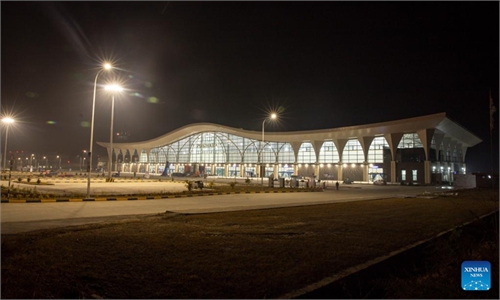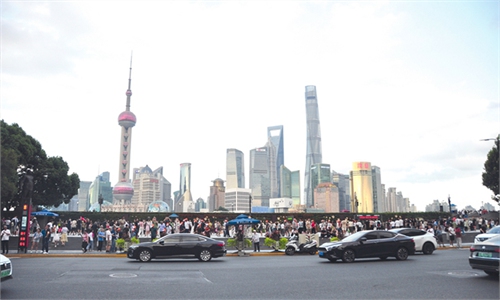
Foreign tourists enjoy themselves at Tiantan in Beijing. Photo: VCG
China's tourism sector has largely bounced back as major benchmarks have returned to their pre-pandemic levels in 2023. The China Tourism Academy, a research institute under the Ministry of Culture and Tourism, has forecasted the overall tourism revenues will reach 5.2 trillion yuan ($735 billion) this year, or hitting 91 percent of the figure for 2019.Industry analysts expect the tourism will continue to rebound in 2024, with the sector revenues possibly exceeding 5.9 trillion yuan provided the economy keeps powering ahead and Chinese families have more spare money in their pockets.
The tourism industry's spectacular revival, which kicked off with the lifting of the COVID-19 pandemic restrictions about 12 months ago, gathered momentum with the spring travel and summer vacation witnessing substantive booms. And, in the broad Asia and Pacific region, Chinese tourist arrivals more than quadrupled compared with a year ago, with nearly all tourism destinations reopened. In 2023, more Chinese people chose to explore nearby provinces and cities within the country, partially because they still feel safer strolling and staying at a place near home.
Currently, there is a surge in the number of passengers at airports and train stations, and tickets to popular museums and heated scenic spots are difficult to buy, making tourism one of the biggest contributors to domestic consumption recovery this year. Owing to multiple supportive policies, the country's tourism market is recovering steadily in 2023, and tourist arrivals and spending are showing bright results.
During the Golden Week (September 29 - October 6) national holidays, domestic tourism revenues reached 753.5 billion yuan, or an increase of 1.5 percent from the 2019 levels, according to the Ministry of Culture and Tourism. The number of domestic tourist trips rose by 4.1 percent to reach 826 million during the long holidays. On a per capita basis, tourist spending returned to 98 percent of 2019 levels.
The rebound was boosted by strong pent-up demand and improved public confidence in outings following the three-year pandemic strike. And, within the Chinese mainland, tourism recovery was mainly driven by domestic demand, as inbound travel by overseas sightseers has yet to see a similar recovery. Long deemed a prime economic contributor, accounting for some 11 per cent of China's annual gross domestic demand in 2018 and 2019, the sector's revival is something of a bellwether for the government's efforts to revitalize the important job market and stimulate home consumption.
With train tickets for the impending 2024 New Year's Day holidays now up for sale online, hotel bookings surged by more than four times so far in December. While the domestic tourism industry is recovering rapidly and outbound tourism is bouncing back, the continuing downturn in China's inbound tourism market has stirred up some concerns. Several seminars have been held and many articles published over the past few months to give suggestions on the measures the authorities can take to boost the recovery of inbound tourism.
The number of inbound tourists reflects a country's global appeal and competitiveness. Inbound tourism also earns foreign exchange and increasing its attractiveness to overseas tourists. Inbound tourism involves many elements, including international relations, destination marketing, visa policies, international airlines, mobile payment systems, cultural diversity, and consumption habits.
The government moved to experiment visa-free travel for citizens from Germany, France, Italy, the Netherlands, Spain and Malaysia for a trial period of 12 months. From December 1 to November 30 next year, ordinary passport holders from these countries can do business and travel in China without a visa for up to 15 days. The measure, promoting China's comprehensive opening-up policy, will also facilitate inbound tourism development, industry experts say.
Statistics from China's National Immigration Administration show that, the number of inbound travelers from overseas has kept rising since December 1 when the new policy was implemented. Hopefully, more such easing policies will be worked out in 2024.
Meanwhile, Chinese embassies in many countries are announcing that some visa applicants have been exempted from fingerprint collection, and the authorities are mulling increasing international flights to and from China. Also, the recent upgrading of WeChat Pay and Paypal will enable foreign users to link international cards to their phones and use the mobile payment system in China.
Friendship develops and strengthens due to close contact between people, and is critical to sound state-to-state relations. Overseas tourists can have a direct and objective experience of a country by traveling to different Chinese cities and tourist attractions. The development of inbound tourism will allow more overseas tourists to experience China's rich culture, beautiful natural scenery, and allow them interact with the local people.
The healthy development of inbound tourism, however, depends on the joint efforts of government departments and the tourism industry. The relevant authorities should implement favorable policies to promote inbound tourism and set long- medium- and short-term goals to solve problems related to visa, international flights, payment system, ticket booking, price competition and talent training. Diversified marketing policies should also be introduced, keeping in mind the cultural and social differences, to target new markets, while the authorities need to work with local tourism agencies and related government departments to establish a dedicated website to provide information on visa, tickets, customs and hotels in multiple languages.
Also, new technologies such as big data, artificial intelligence and virtual reality should be used to enhance overseas tourists' experience in China, so that an increasing number of overseas tourists can experience the real and multi-dimensional China.
From 2020 to 2022, when the COVID-19 pandemic hit, international travel was brought to a grinding halt. The pandemic caused as many as 16 million jobs lost from the country's travel and tourism sector, when its contribution to China's national economy plunged by almost 90 percent. In 2023, the sector's pre-pandemic 11 percent contribution to GDP is coming back and being restored.
The author is an editor with the Global Times. bizopinion@globaltimes.com.cn



